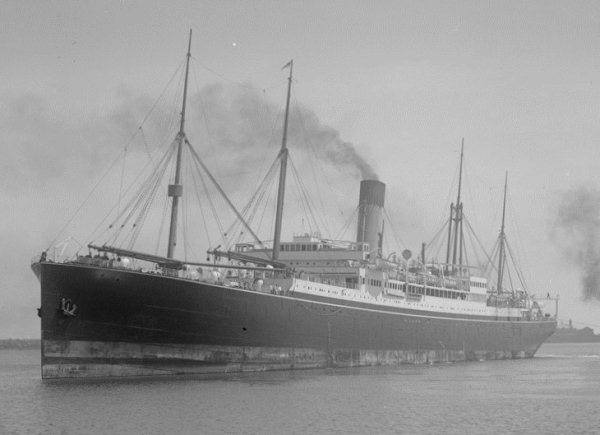Ceramic
British Steam passenger ship

Photo courtesy of Allan C. Green Collection
| Name | Ceramic | ||
| Type: | Steam passenger ship | ||
| Tonnage | 18,713 tons (one of the largest ships sunk). | ||
| Completed | 1913 - Harland & Wolff Ltd, Belfast | ||
| Owner | Shaw, Savill & Albion Co Ltd, London | ||
| Homeport | Southampton | ||
| Date of attack | 7 Dec 1942 | Nationality: | |
| Fate | Sunk by U-515 (Werner Henke) | ||
| Position | 40° 30'N, 40° 20'W - Grid CD 2927 | ||
| Complement | 655 (654 dead and 1 survivor). | ||
| Convoy | ON-149 (detached) | ||
| Route | Liverpool (26 Nov) - St. Helena - Durban - Sydney, Australia | ||
| Cargo | 12,362 tons of general cargo and government stores | ||
| History | Completed in July 1913 for White Star Ltd (Oceanic Steam Navigation Co), Liverpool. Used on the the Australian Service, for years she was the largest ship sailing between Europa and Australia. In 1914 requisitioned as troopship for the Australian Expeditionary Force (AEF). In May 1916 she had a narrow escape from a torpedo attack in the Mediterranean with 2500 troops on board. On 9 June 1917, Ceramic had another narrow escape from a torpedo attack in the English Channel. On 21 July 1917, she was chased by a surfaced U-boat but escaped due her greater speed. After the war returned to owner and in service between Liverpool and Sydney. On 18 December 1930 Ceramic collided with the British motor merchant Laguna on the Thames near Gravesend. Both vessels were slightly damaged. In February 1934 the Cunard White Star Line was formed, the Australian assets were acquired together with Ceramic by Shaw, Savill & Albion Co Ltd, London. 1935 she was reconstructed by Harland & Wolff Ltd, Govan (former tonnage 18,481 grt). In February 1940 once again requisitioned as troopship between Australia and Europe, but later carried passengers under Government control. On 11 August 1940, Ceramic collided with the British motor merchant Testbank and had to be towed to Walvis Bay and was later repaired in Capetown. | ||
| Notes on event | On 26 November 1942 the Ceramic (Master Herbert Charles Elford) left Liverpool in convoy ON-149 with 264 crew members, 14 gunners, 244 military and naval passengers (including 30 nurses of the Queen Alexandra’s Imperial Military Nursing Service) and 133 fare paying passengers, among them 12 children. On 5 December, she was detached from convoy and began sailing independently as routed. Just at midnight on 6/7 December, the Ceramic was hit by one torpedo from U-515 about 420 miles west-northwest of the Azores. On action stations were sounded and two or three minutes later two more torpedoes struck the engine room below the waterline. The engines stopped and the vessel was plunged into darkness. There was very little panic among the passengers and the crew launched approximately eight full laden lifeboats, despite of the cold weather, the rough seas and the poor visibility in the darkness. The Ceramic stayed afloat and three hours later U-515 hit the ship with two more torpedoes, which broke her in two and she sank immediately. By this time, the sea was very rough and it was raining. The lifeboats were becoming swamped and needed continual bailing out. Some lifeboats capsized and threw the occupants into the water, so that many people were floating in the water, supported by their life jackets. Henke reported the sinking to the BdU and was ordered to return to the site to find the master and to find out where she had been bound. At about midday, the surfaced U-515 returned. A lookout first saw a body, then empty life jackets and the broken mast from the ship. A lifeboat whose occupants waved to him was also seen. It was reported later that Henke was very upset at the sight that greeted him. At this time the wind had almost reached Force 10 and a storm started. The sea was almost swamping the conning tower, so Henke ordered his men to take the first survivor that came close enough to his vessel. Two men threw a rope to one of the men in the water, Sapper Eric Munday of the Royal Engineers, took him aboard and U-515 left the area. A distress signal from Ceramic had been heard and HMS Enterprise (D 52) (Capt H.T.W. Grant, RCN) and the Portuguese destroyer Dao were sent to search for survivors on 9 December, but none were found. Other sailors in the area considered later that this storm was one of the worst storms that they had experienced. | ||
| More info | |||
| On board | We have details of 655 people who were on board. | ||
If you can help us with any additional information on this vessel then please contact us.
